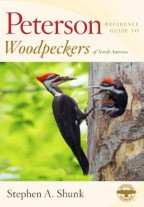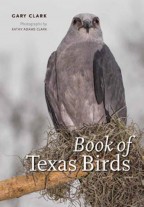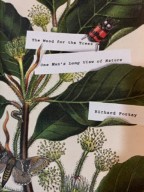Mark Lynch
Peterson Reference Guide to Woodpeckers of North America. Stephen A. Shunk. 2016. Boston: Houghton Mifflin Harcourt.
Book of Texas Birds. Gary Clark. 2016. College Station, Texas: Texas A & M University Press.
The Wood for the Trees: One Man’s Long View Of Nature. Richard Fortey. 2016. New York: A. Knopf.
Here are three books that look at the natural world in three different scales of geography: an overview of an avian sub-family in a continent, most of the birds that are seen in one state, and an attempt to inventory the entire natural and human history of one’s home turf.
 Another early naturalist (and pioneer of bird photography), Herbert Job, placed woodpeckers in their very own order, the “International Order of the Knights of the Chisel.” (p. xi, Peterson Reference Guide to Woodpeckers)
Another early naturalist (and pioneer of bird photography), Herbert Job, placed woodpeckers in their very own order, the “International Order of the Knights of the Chisel.” (p. xi, Peterson Reference Guide to Woodpeckers)
Woodpeckers are a beloved and charismatic subfamily (Picinae) of birds. Here in Massachusetts, they range in size from the diminutive Downy to the impressive Pileated. Though some migrate, many are permanent residents and are among the few species to be found in the silent forests of a New England winter. Woodpeckers have fascinating behaviors too, like the loud drumming they perform to announce territories, excavating their deep nest holes, or sucking up sap. Woodpeckers have even been immortalized in classic animations, though I am the first to admit that I find Walter Lantz’s Woody Woodpecker more annoying than endearing. Finally, one species of woodpecker, the Ivory-billed, remains the ultimate mysterious “ghost bird,” and recent reports of this species have ornithologists and birders wondering if this magnificent bird could still be alive.
Stephen Shunk is the perfect choice for an author of a book on woodpeckers. He lives on the eastern slope of the Cascade Range in Oregon where there are eleven breeding species of woodpeckers. His considerable expertise and enthusiasm for woodpeckers has created a book that is as informative as it is enjoyable.
Introductory chapters include a fascinating section on woodpecker anatomy and adaptation that details the uniqueness of these species. For example, woodpeckers have very long and unusual tongues, some of which can extend inches beyond the tip of the bill. This allows them to probe for prey deep in the holes they have drilled in bark. The tips of woodpecker tongues are also specialized, some having stiff and hornlike barbs angled backwards to actually hook prey. Woodpeckers also have a larger submaxillary salivary gland than most birds, which coats the tongue with very sticky mucus on its way out of the bill to also aid in firmly gluing prey items to the tongue tip.
There are chapters on woodpecker feeding, communication, social interactions, locomotion, and ecology and conservation. Shunk describes woodpeckers as “keystone organisms” in the ecosystems of temperate forests and woodlands. This is a species whose behaviors are key to maintaining a healthy ecosystem. Woodpeckers are important because they control insects that are destructive to trees, thereby helping to maintain healthy forests. Woodpeckers also excavate cavities that can help support a community of other cavity nesting species. There are a number of non-avian species, mostly insects but also certain species of hummingbirds, that use the sap wells left by some woodpecker species.
The 23 species accounts make up the bulk of this book. Each account includes a few introductory paragraphs, followed by detailed sections on distribution and range (with detailed maps), habitat preferences, detection and visual identification, behavior, conservation, and a list of references. The entire book is illustrated with 250 photographs, mostly in full color, including many full page shots. All the photography is of the highest quality. The book concludes with appendices, a glossary, a bibliography, and an index.
Shunk’s writing elevates this book beyond simply a dry recitation of the basic facts about woodpecker species.
John James Audubon once described the Red-headed Woodpecker as living its “whole life (as) one of pleasure.” Perhaps the most striking of the continent’s Picinae, the “Red-head” glows like a burning flame atop its favorite snapped-off tree tops. (p. 53)
In every account, the reader will find something new to learn even about familiar species. For instance, it has been suggested that to escape detection by ravens, the American Three-toed Woodpecker uses an unusual defense posture by mimicking fungal conks on the bark of trees (see illustration p. 204).
Of course, Shunk includes a complete account of the Ivory-billed Woodpecker, detailing population changes and recent search efforts along with its current conservation status and “management” schemes. But as Shunk concludes: “Thousands of cumulative search hours failed to produce irrefutable proof that the species remains.” (p. 250)
The Peterson Reference Guide to Woodpeckers of North America is another outstanding volume in this “must own” series and is a book that is enjoyable to read, beautiful to look at, and useful as a home reference guide.
 I wrote the majority of this book while sitting in a stone cabin during vacations at Big Bend National Park. The cabin and the sounds of birds provided a haven from the distractions of normal daily life, which then included work as a college dean and later as a college vice president. (ix, Book of Texas Birds)
I wrote the majority of this book while sitting in a stone cabin during vacations at Big Bend National Park. The cabin and the sounds of birds provided a haven from the distractions of normal daily life, which then included work as a college dean and later as a college vice president. (ix, Book of Texas Birds)
The large format Book of Texas Birds is not an exhaustive atlas of the birds that breed in or migrate to Texas. There are no range maps, and pelagic species aren’t even mentioned. There are no lengthy introductory chapters on the history of birding in the state, no descriptions of habitat types, no illustrations of bird topography. There isn’t even a single map of the state that includes all the areas listed casually in the text, which I found frustrating. The Book of Texas Birds is instead a highly personal account of the bird species seen inland or right along the coast by one of the foremost birders in the state. Each species account is typically illustrated by a single color photograph taken by Kathy Adams Clark, the author’s wife. “It is for the people who wonder about birds that this book is written.” (p. 1) This is a book written primarily for Texan birders or out-of-state birders who go there often.
The Book of Texas Birds comprises species accounts only; sometimes two species are treated in one account. This includes Mottled and Black ducks and Clapper and King rails. These accounts are chatty. Key identification points are those that Clark thinks have helped him. Sometimes this comes down to some very basic advice: “So play the odds. Salt marsh—probably clapper; freshwater marsh—probably king.” (p. 119)
The accounts read as if you are out in the field with Clark as he casually conveys some of his hard-earned wisdom and unique experiences with each species. This excerpt from the account of the Greater Roadrunner is a good example:
We had a great time at a campsite one summer evening simply watching the antics of a greater roadrunner. The bird sauntered cautiously around the periphery of our campsite as we cooked dinner on our camp stove. We moved slowly and quietly so as not to scare the bird away. The bird gradually drew within three feet of us, eating scraps of food we’d dropped on the ground while cooking. We were able to examine up close the interlaced chromatic green, tans, and blues of the bird’s feathers.
The roadrunner lowered its head, bellowed its neck, and let forth a low cooing call that sounded like a French horn. Its apparent mate, stationed a hundred yards away, responded with the same call. Our roadrunner erected the feathers on its crown and cocked its head to the side. Was it trying to signal to its mate that the coast was clear? I don’t know. I do know that the roadrunner, so common as to be virtually ignored by some bird watchers, gave us uncommon joy that evening. (p. 200-01)
Filled with anecdotes and personal identification tips, the species accounts really express Clark’s love of watching birds. At the end each account there are short headings for brief notes on diet, voice, nest, and “where found in Texas.” The last category is sometimes general, and this is where I missed detailed range maps being included.
Of course, the reader will be intrigued as to what Clark has to say about the Ivory-billed Woodpecker. Most of the two-page account is concerned with the 2004 “discovery” of a possible Ivory-billed by Tim Gallagher and Bobby Ray Harrison in Alabama. Clark refers to those who have doubts about this sighting as “skeptics” and later adds:
Full disclosure: Tim Gallagher and Bobby Ray Harrison are my friends, as are some of the acclaimed birders who doubt the accuracy of the ivory-billed sighting. But I’d put Gallagher’s observational acumen at the top of the list of field identifiers of birds. He’s among the most cautious, careful bird observers I’ve ever known. Whereas some birders may reasonably question the ivory-billed sighting, any vilification of Gallagher and Harrison is wholly unjustified. (p. 255)
A few paragraphs later, under “where found in Texas”, Clark writes: “Probably extinct, though hope plus research abounds for discovery of a remnant population.” (p. 255)
Book of Texas Birds is not a where-to-go book, nor is it a definitive checklist of all the species that have appeared in the state. This isn’t even an identification guide containing minute details on plumages and molts. The Book of Texas Birds is instead a lively account of most of the species of a large state written by a man who knows those birds better than most.
 After a working life spent in a great museum, the time had come for me to escape into the open air. I spent years handling fossils of extinct animals; now, the inner naturalist needed to touch living animals and plants. (p. 3, The Wood For the Trees)
After a working life spent in a great museum, the time had come for me to escape into the open air. I spent years handling fossils of extinct animals; now, the inner naturalist needed to touch living animals and plants. (p. 3, The Wood For the Trees)
There is a long history of British nature writing about one’s local patch. The Natural History and Antiquities of Selborne, written in 1789 by Gilbert White, is one of the earliest examples of a book that tracks the seasonal changes in the fields and woodlots of the author’s hometown while also including an account of the town’s long human history. A more recent example of this genre is A Buzz in the Meadow: the Natural History of a French Farm by Dave Goulson, published in 2016. In these books, the authors observe closely the ecology of his or her hometown or personal property to look at the grand scheme of “nature” and how it changes through a year or more. Some of these books take the form of a journal. One of the great pleasures of reading these local-patch books is discovering the tremendous variety of species that can occur in such a small space, and this gives the reader a deeper sense of the complexity and diversity of the world’s ecosystems. The reader also learns about the changes that occur through the cycle of the seasons, year after year. As William Blake wrote in his poem Auguries of Innocence (1803): “To see a World in a Grain of Sand/ And a Heaven in a Wild Flower/ Hold Infinity in the palm of your hand/ And Eternity in an hour.”
The Wood for the Trees is certainly a local-patch book, but one with a difference. The author, Richard Fortey, is a gifted natural historian of paleontology. He spent his professional life among the dusty collections rooms of a great museum puzzling over inert fossils. Along the way, he wrote a number of popular and enjoyable books about trilobites, the evolution of life, and the human history of the museum’s collections. His life changed dramatically when he retired and he and his wife bought a home and some land in the classic English countryside of the Chiltern Hills northwest of London. Their home in Grim’s Dyke Wood is nestled in a tract of beech woods growing atop hills made of “clay-with-flints,” a unique habitat most of us in the States have had no experience with.
Fortey decides to explore every aspect of his new world, keeping a monthly journal of his discoveries. The prospect of finally looking at living nature makes him giddy with anticipation of what he will discover:
Once the project was under way, a curious thing happened. I wanted to make a collection. This may not sound particularly remarkable, but for somebody who had worked for decades with rank after rank of curated collections it was a rejuvenation. Life among the stacks in the Natural History Museum in London had stifled my acquisitiveness, but now something was rekindled. I wanted to collect objects from the wood, not in the systematic way of a scientist, but with something of the random joy of a young boy. Perhaps I wanted to become that boy once again. (p. 5)
The Wood for the Trees begins in April and follows Fortey’s discoveries throughout a year. He writes about whatever he comes across in his walks in the woods. This includes the birds, mammals, flowers, trees, fungi, beetles, moths, crane flies, spiders, and other life he discovers. The advantage to being connected to a great natural history museum is that he has a huge staff of experts in their own fields to consult and check his identifications. Several times a cherry picker is brought out to Grim’s Dyke Wood so entomologists can take an inventory of the invertebrate life found in the tops of the forest.
There is also a long and fascinating human history of the Chiltern Hills. Signs of the human occupation of Grim’s Dyke Wood can be found just beneath the leaf litter in a number of locations on Fortey’s property. In every chapter, Fortey recounts a piece of this complex story. It begins in the Neolithic period and much later includes the Roman occupation, and on through the Anglo-Saxon years to the establishment of the imposing manor of the Greys, which is still there today. As long as there were human populations in the Chiltern Hills, forest lots like Fortey’s were managed so that they would continually produce products for the local population to use. So the reader of The Wood for the Trees learns about flint mining, coppicing of trees, and even how to make a liqueur known as “beech leaf noyau.” Fortey finds ways to use several of the materials of his woods in his home. This includes the building of a stunning collection cabinet for his discoveries made out of planks from a felled cherry tree. Besides being a fine local natural history, this book is also a concise history of Britain from the local patch point of view.
The Wood for the Trees also features several maps, a number of black-and-white illustrations, and two sections of color photographs. If you are passionate or curious about British natural history and the history of humans in the British countryside, this is a perfect book for you. It may also inspire you to take the long and deep view of your own neck of the woods.
Literature Cited
- Goulson, Dave. 2016. A Buzz in the Meadow: The Natural History of a French Farm. New York: Picador.
- White, Gilbert. 2004. The Natural History and Antiquities of Selborne. London: Thames and Hudson.